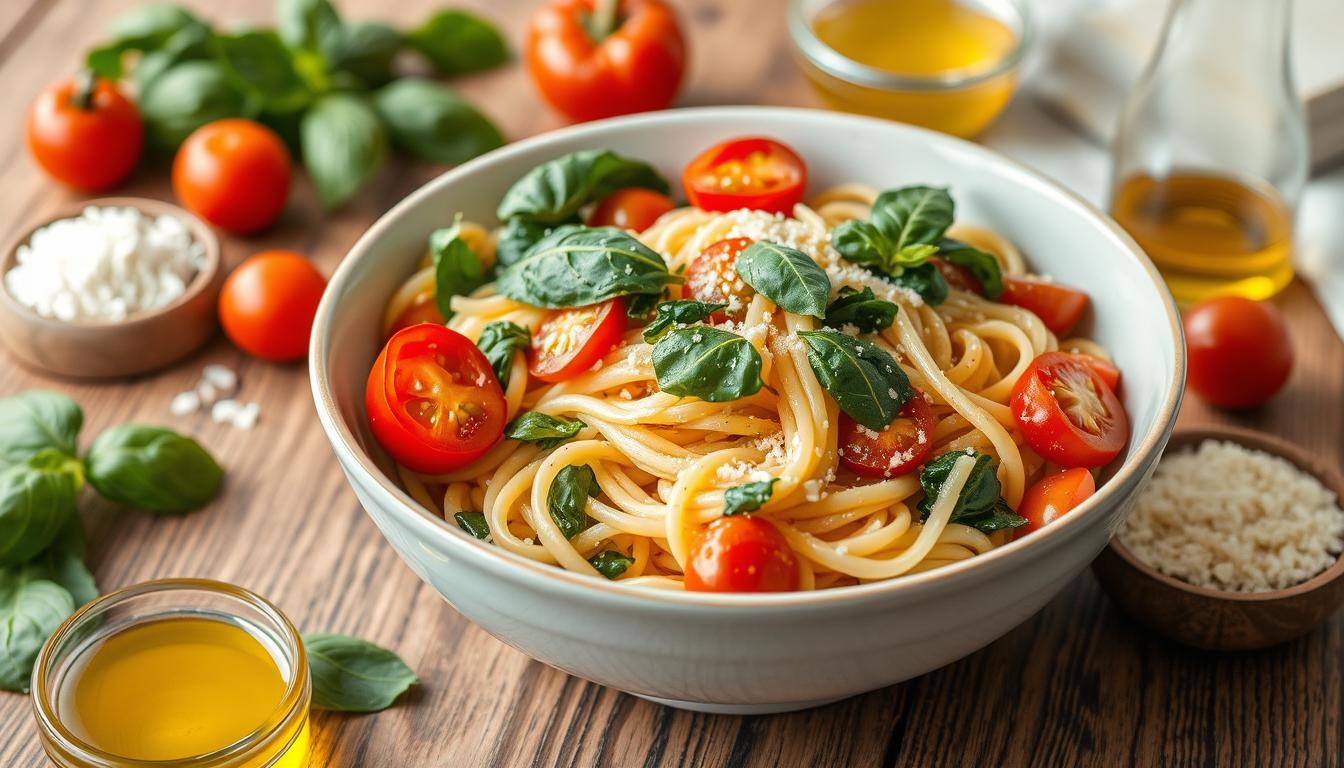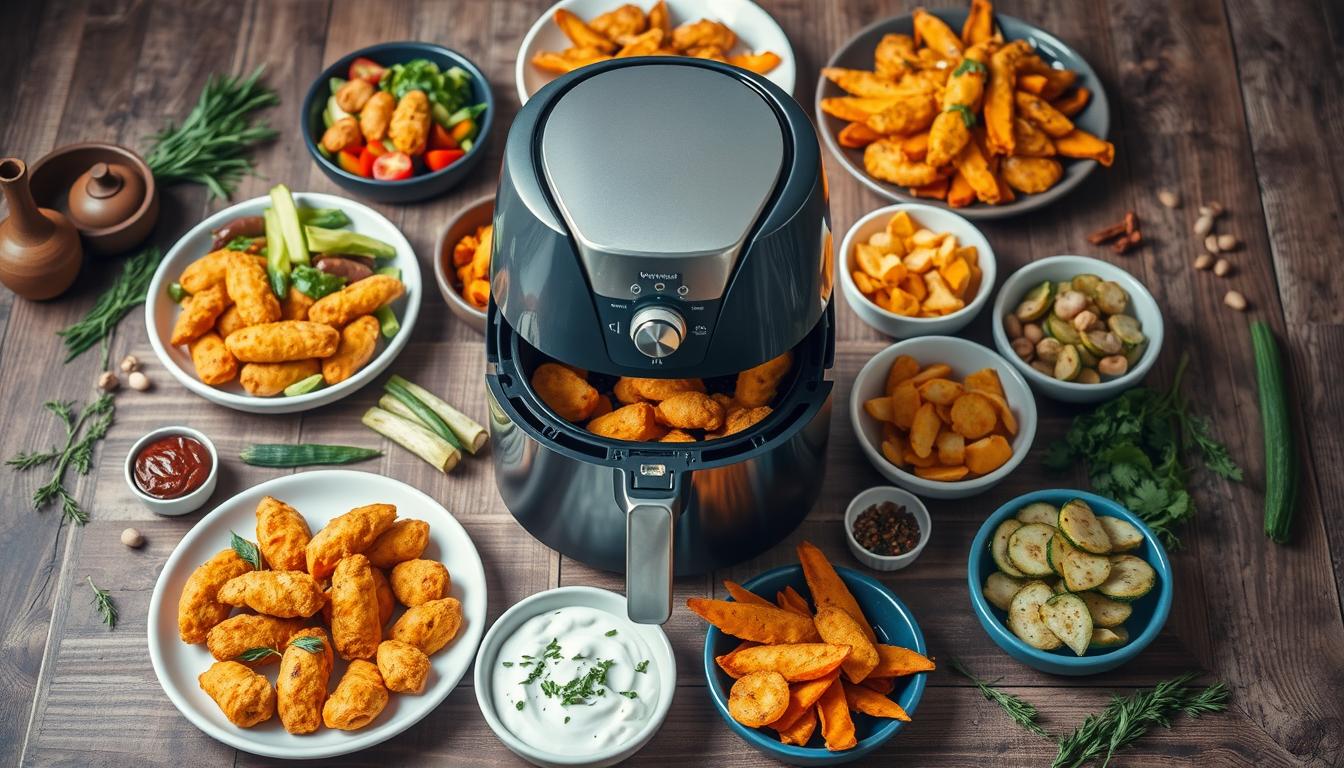Did you know that 43 low-sodium vegetarian recipes were analyzed? They show a wide range of flavors and cooking methods. You’ll find dishes from Mediterranean to Mexican cuisine.
These tasty meals are great for lowering sodium and enjoying plant-based food. They’re perfect if you want to lower blood pressure, manage health conditions, or live a heart-healthy life. Try these 15 easy low-sodium vegetarian recipes and enjoy delicious, healthy food.
Understanding the Importance of Low Sodium Vegetarian Cooking
Lowering your sodium can help your heart and blood pressure. Doctors say to eat less than 2,000 mg of sodium daily. For most adults, 1,500 mg is better. Low-sodium vegetarian meals are tasty and keep you within these limits.
Health Benefits of Reducing Sodium Intake
Eating less sodium can lower your blood pressure a lot. It can also cut your risk of stomach cancer by 12% for every 5-gram increase in salt.
Why Choose Vegetarian Low-Sodium Options
More people are eating vegetarian for health reasons. It can lower heart disease, diabetes, and some cancers risk. But, some vegetarian foods can be high in sodium and unhealthy fats. Choosing low-sodium vegetarian meals helps you stay healthy and enjoy a plant-based diet.
Daily Sodium Recommendations
The American Heart Association suggests no more than 2,300 mg of sodium daily. The ideal is 1,500 mg for most adults. It’s hard to meet this with today’s high-sodium foods. Cooking low-sodium vegetarian meals is a tasty way to follow these guidelines.
Learning about low-sodium vegetarian cooking is key to better health. It’s a smart choice for a healthier, more balanced life.
Essential Ingredients for Low Sodium Vegetarian Cooking
Making tasty veggie dishes for hypertension, plant-based low-sodium meals, and heart-healthy meals begins with the right stuff. For plant-based cooking, choose fresh veggies, legumes, whole grains, and herbs and spices. These add flavor without too much sodium.
Chickpeas, lentils, and quinoa are key for many tasty, low-sodium vegetarian dishes. Add colorful veggies like eggplant, zucchini, and bell peppers. They make your meals look good and packed with nutrients.
Herbs and spices help make your low-sodium vegetarian cooking dishes pop. Use basil, cilantro, thyme, cumin, paprika, and garlic powder. They boost flavor without adding salt.
Using these ingredients, you can make veggie dishes for hypertension, plant-based low-sodium meals, and heart-healthy meals that are good for you and taste great. Try out new flavors and cooking ways to find your favorite plant-based cooking dishes.
Quick and Easy Low Sodium Vegetarian Recipes
Try a salt-free diet with these quick and easy vegetarian recipes. They’re perfect for those with dietary needs or just looking for tasty meals. You’ll find stovetop dishes, one-pot meals, and sheet pan dinners that are easy to make.
Stovetop Recipes Under 30 Minutes
Make a 20-minute vegan curry with spices, veggies, and coconut milk. Or, try a 3-ingredient pasta with noodles, mushrooms, and herb-garlic sauce. Stuff baked potatoes with salsa, black beans, and avocado for a filling meal.
One-Pot Meal Solutions
Enjoy a warm vegetarian chili with beans and veggies. It has 72mg of sodium per serving. Compare that to regular chili’s 1000 mg per cup. Also, try a one-pot pasta primavera with noodles, Brussels sprouts, tomatoes, and lemon-garlic sauce.
Simple Sheet Pan Dinners
Roast cauliflower steaks with a spanakopita filling for a protein-rich meal. Or, make a colorful vegetable grain bowl with roasted veggies, quinoa, and citrus dressing.
These quick and easy vegetarian recipes offer a variety of flavors and textures. They’re great for your health and taste buds. Explore and find new dishes that fit your dietary needs.
Flavorful Alternatives to Salt in Vegetarian Cooking
Looking for meatless delights and healthy eating options? Finding wholesome ingredients that are tasty without salt is key. There are many ways to make your vegetarian dishes flavorful without using a lot of sodium.
Try using lemon juice, vinegar, and fresh herbs and spices. Basil, oregano, cumin, and smoked paprika add depth to your meals. Nutritional yeast gives a cheesy taste without the salt.
For a big flavor boost, use sun-dried tomatoes, olives, or miso paste. They make your dishes richer and tastier. Roasting veggies also brings out their sweetness, making them flavorful without needing extra seasoning.
| Flavor-Boosting Ingredient | How it Enhances Vegetarian Cooking |
|---|---|
| Lemon Juice and Vinegar | Adds a bright, tangy note to balance flavors |
| Fresh Herbs and Spices | Provides aromatic, savory, and earthy notes |
| Nutritional Yeast | Imparts a cheese-like umami flavor |
| Sun-Dried Tomatoes and Olives | Contributes rich, concentrated flavors |
| Roasted Vegetables | Enhances natural sweetness and depth of flavor |
Using these flavorful alternatives can make your meatless delights and healthy eating better. Try different mixes to find the wholesome ingredients you like best.
“Cooking with herbs and spices is a game-changer for adding flavor without salt. It’s amazing how much depth and complexity you can achieve in vegetarian dishes this way.”
The American Heart Association says to limit sodium to 2,300 milligrams a day. Aim for 1,500 milligrams for most adults. Finding salt-free flavor options is key for healthy eating and no salt vegetarian meals. With more people needing low-sodium diets for health reasons, these wholesome ingredients are a big help for your meatless delights.
Heart-Healthy Bean and Legume Dishes
Every February, we celebrate Heart Health Awareness Month. It’s a great time to try low sodium vegan recipes and healthy low sodium recipes with beans and legumes. These low sodium plant-based meals are good for your heart and body.
Beans are full of nutrients like antioxidants, fiber, and protein. They also have B vitamins, iron, and more. Eating more beans can help prevent diseases and help with weight control.
Protein-Rich Options
Legumes are a great source of plant-based protein. They are low in fat and high in fiber. Try vegetarian black bean chili or lentil bowls for a protein-packed meal.
Fiber-Packed Meals
Beans and legumes are also full of fiber. Fiber is good for your heart and overall health. Make a chickpea and zucchini burger or a mixed bean salad with fresh veggies and greens.
When cooking with beans and legumes, watch the sodium. Use low-sodium or no-salt-added options for heart-healthy meals. You can make tasty and healthy low sodium vegan recipes, healthy low sodium recipes, and low sodium plant-based meals for your body and heart.
| Nutritional Information (per serving) | Quantity |
|---|---|
| Calories | 303kcal |
| Carbohydrates | 55g |
| Protein | 13g |
| Fat | 5g |
| Saturated Fat | 1g |
| Polyunsaturated Fat | 1g |
| Monounsaturated Fat | 3g |
| Sodium | 44mg |
| Fiber | 14g |
| Sugar | 7g |
| Vitamin A | 6608IU |
| Vitamin C | 50mg |
| Calcium | 163mg |
| Iron | 4mg |
This heart-healthy mixed bean salad recipe is a great way to use beans and legumes. It’s nutritious and filling. Add protein, grains, veggies, greens, nuts, and garnishes to make it even better.
Keep the salad fresh by storing it in airtight containers in the fridge for 3 to 4 days. Enjoying low sodium vegan recipes, healthy low sodium recipes, and low sodium plant-based meals with beans and legumes is delicious and good for your heart.
“Beans are a nutritional powerhouse, providing essential vitamins, minerals, and fiber that support overall health and well-being. Incorporating them into your diet is a simple yet impactful way to cultivate a heart-healthy lifestyle.”
Looking for a hearty chili, a vibrant salad, or a satisfying burger? Try low sodium vegan recipes, healthy low sodium recipes, and low sodium plant-based meals with beans. Your heart will thank you!
Fresh Vegetable-Based Main Courses
Looking for easy and tasty vegetarian recipes that are low in sodium? Check out these fresh vegetable-based main courses. They highlight the natural goodness of produce and keep sodium levels down.
Begin with a grilled eggplant and tomato pasta dish. It combines roasted eggplant and juicy tomatoes for a fulfilling, yet light dinner. For a heartier choice, try stuffed portobello mushrooms. They’re filled with a creamy spinach and feta mix.
Want something more vibrant? Make a green shakshuka. It has sautéed chard and spinach topped with poached eggs. This dish is both nutritious and flavorful, perfect for enjoying veggies while keeping sodium low.
These vegetable-based main courses offer a tasty and satisfying meal. They’re packed with essential nutrients. By using fresh, whole foods and less salt, you get meals that are good for you and taste great.
A balanced low-sodium vegetarian diet focuses on veggies, grains, and plant proteins. It uses herbs and spices to add flavor, not salt. Try these fresh and delightful vegetable-based main courses to add variety and nutrition to your meals.
Wholesome Grain and Pasta Dishes
Try whole grains and pasta for your vegetarian dinners. Quinoa and brown rice are great for grain bowls. Whole wheat pasta is a better choice than regular pasta. These options are full of fiber and complex carbs.
They also let you try different vegetarian meals without salt.
Quinoa and Rice Bowls
Quinoa and brown rice are great bases for meals. Mix them with roasted veggies, legumes, and herbs for a tasty bowl. You can also add vegan breakfast items like sautéed greens or tofu for a healthy start.
Whole Wheat Pasta Options
Choose whole wheat pasta for more fiber and nutrients. It’s perfect with vegetarian dinners, like veggie primavera or mac and cheese. Whole wheat pasta tastes nutty and feels more filling.
| Dish | Prep Time | Servings | Calories | Total Fat | Saturated Fat | Sodium | Carbohydrates | Fiber | Sugar | Protein |
|---|---|---|---|---|---|---|---|---|---|---|
| Vegetarian Spaghetti | 25 minutes | 4 | 185 | 5g | 1g | 535mg | 29g | 3g | 4g | 7g |
| Whole Wheat Pasta Primavera | 20 minutes | 6 | 423 | – | – | – | 21% | – | – | 40% |
Whole grains and pasta are great for healthy meals. They’re good for quick bowls or comforting pasta dishes. These options are tasty and low in sodium.
Tips for Making Low Sodium Vegetarian Meals Tasty
Low-sodium vegetarian meals can be very tasty. You don’t need a lot of salt to make them delicious. Just use a few simple tricks to boost the flavor.
Using fresh herbs is a great way to add flavor. Try basil, cilantro, rosemary, or thyme to make your dishes more interesting. Citrus zests like lemon or lime can also add a nice zing to your meals.
Vinegars are another great option. Use balsamic, red wine, or apple cider vinegar for a sweet and tangy taste. Roasting or grilling can also bring out the natural flavors of your ingredients.
Look for ingredients that are rich in umami. Mushrooms or tomatoes can add depth and richness without salt.
By trying different herbs, citrus, vinegars, and umami-rich ingredients, you can make tasty low-sodium meals. Your taste buds will thank you.
| Ingredient | Culinary Application | Flavor Profile |
|---|---|---|
| Fresh Herbs | Chopped or whole leaves | Aromatic, earthy, bright |
| Citrus Zest | Grated or peeled | Tangy, refreshing, elevating |
| Vinegars | Drizzled, used in marinades | Tart, acidic, balancing |
| Umami-rich Ingredients | Incorporated into dishes | Savory, depth, richness |
Creating tasty low-sodium vegetarian meals is all about experimenting. Try different flavors and techniques. This way, you can enjoy healthy, flavorful dishes without too much sodium.
Conclusion
Low-sodium vegetarian cooking is great for your health and taste buds. It lets you make tasty and healthy meals with veggies, legumes, and whole grains. This article shows you how to make yummy, low-sodium vegetarian dishes.
Eating less sodium with plants can lower your risk of heart disease and diabetes. You’ll get important vitamins, minerals, and fiber from these foods. Try out these tasty, low-sodium vegetarian recipes for a better life.
A smart low-sodium vegetarian diet is good for your heart and helps with weight. Try new foods and cooking ways to make meals that are both delicious and good for you.
FAQ
What are the key ingredients for low-sodium vegetarian cooking?
For low-sodium vegetarian cooking, use fresh veggies, legumes, whole grains, and herbs and spices. Chickpeas, lentils, quinoa, and colorful veggies make meals tasty and healthy. Herbs like basil and thyme, and spices like cumin, add flavor without salt.
What are some quick and easy low-sodium vegetarian recipes to try?
Try quick recipes like vegan curry in 20 minutes, 3-ingredient pasta dinner, and stuffed baked potatoes. One-pot meals include vegetarian chili and pasta primavera. Sheet pan dinners offer roasted cauliflower and vegetable grain bowls.
How can I enhance flavors in low-sodium vegetarian meals without using salt?
Use lemon juice, vinegar, herbs, and spices to add flavor. Try smoked paprika, nutritional yeast, or miso paste for umami. Roasting veggies and using sun-dried tomatoes or olives adds depth without salt.
What are some protein-rich and fiber-packed low-sodium vegetarian meals?
Use beans and legumes for protein and fiber. Try vegetarian black bean chili, lentil bowls, or chickpea burgers. These meals are nutritious and low in sodium, good for heart health.
What are some wholesome grain and pasta dishes for low-sodium vegetarian cooking?
Use quinoa, brown rice, and whole wheat pasta for wholesome dishes. Try quinoa bowls, brown rice stir-fries, or whole wheat pasta primavera. These dishes are fiber-rich and allow for creative flavor combinations.



























